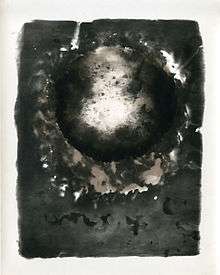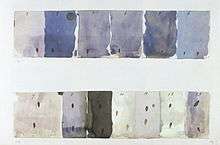Chemigram
A chemigram (from "chemistry" and gramma, Greek for "things written")[1] is an experimental piece of art where an image is made by painting with chemicals on light-sensitive paper (such as photographic paper).

Chemigrams were invented in the 1950s by Belgian artist Pierre Cordier.
History
Johann Schulze is regarded as the first to obtain a chemigram-like image; in 1725, he produced such a work using opaque paper and a bottle of silver salts. Hippolyte Bayard produced another chemigram-like image during sensitization tests he conducted in 1839.[2] In the 1930s and 1940s, the German Edmund Kesting and the French Maurice Tabard produced pictures by painting with developer and fixer on photographic paper. It is the Belgian artist Pierre Cordier (born 1933), however, who has been most responsible for developing and exploring chemigrams.[3] From his early days, in 1956, he was one of its rare practitioners, and contributed to its development by expanding its technical and esthetic possibilities. He adopted the name chimigramme in French in 1958 (chemigram in English and Dutch, Chemigramm in German, chimigramma in Italian, and quimigrama in Spanish and Portuguese), the most widely accepted designation today.[3] In 1974 Josef H. Neumann advanced the process in his chemograms by incorporating optical elements before applying chemicals.[4]
Process

A chemigram is made by painting with chemicals on photographic paper and lies within the general domain of experimentation in the visual arts. It requires the use of materials from silver halide-based photography (light-sensitive paper, developer, and fixer), but it is not a photograph. Like the photogram, the chemigram is made without a camera, yet it is created in full light instead of in the darkness of the darkroom. For this reason it is not "light that writes" (photo graphein in the Greek) but rather "chemistry that writes".
Chemigrams can be made solely with photo paper, developer, and fixer, with results that will somewhat resemble watercolor. The possibilities can be multiplied by using materials from painting (such as varnish, wax, or oil),[5] These kinds of experiments are akin to those of Paul Klee, Max Ernst, and Antoni Tàpies.
Unlike chemigrams the production process of chemograms consists of two different steps. First an enlarger is used to partly or fully process a photographic image onto photographic paper in the darkroom and thereafter the chemicals are applied in full light.[6]
Notes
- "-gram". The New Oxford American Dictionary (2nd ed.).
- Cordier, Pierre (Autumn 1982). "Chemigram: A New Approach to Lensless Photography" (PDF). Leonardo. 15 (4): 262–268. doi:10.2307/1574733. JSTOR 1574733.
- "Definition". Pierre Cordier.
- Gabriele Richter: Joseph H. Neumann. Chemogramme. in: Color Foto. Heft 12, 1976, p. 24.
- Cordier, Pierre (Autumn 1982). "Chemigram: A new approach to lensless photography". Leonardo. 15 (4): 262–268. doi:10.2307/1574733. JSTOR 1574733.
- Hannes Schmidt: Bemerkungen zu den Chemogrammen von Josef Neumann. Ausstellung in der Fotografik Studio Galerie von Prof. Pan Walther. in: Photo-Presse. Heft 22, 1976, S. 6.
References
- (in French) Burguet, Frantz-André (April 1963). "Dialogue avec les faiseurs d'images" [Dialogue with image-makers]. L'Arc. Aix-en-Provence, France. 21.
- (in French) Cartier-Bresson, Anne (2008). Vocabulaire technique de la photographie. Paris: Editions Marval.
- Jäger, Gottfried; Krauss, Rolf H.; Reese, Beate (2005). Concrete photography. Bielefeld: Kerber. ISBN 9783936646740.
- (in French) Poivert, Michel; Gunthert, Michel, André (2007). L'art de la photographie: Des origines à nos jours. Paris: Citadelles & Mazenod. pp. 496–501. ISBN 9782850884405.
- Pollack, Peter (1969), The Picture History of Photography, New York: Abrams, ISBN 978-9800048092
- (in German) Richter, Gabriele (1976). "Joseph H. Neumann. Chemogramme". Color Foto. München, Germany. 12: 24.
- (in German) Schmidt, Hannes (1976). "Bemerkungen zu den Chemogrammen von Josef Neumann. Ausstellung in der Fotografik Studio Galerie von Prof. Pan Walther" [Remarks on Josef Neumann's chemograms. Exhibition in the Fotografik Studio Galerie of Prof. Pan Walther]. Photo-Presse. Hamburg, Germany. 22: 6.
- f&d cartier (2013), Wait and See, Cardiff: Ffotogallery Cardiff, ISBN 978-1872771939
External links
| Wikimedia Commons has media related to Chemigram. |
- "Camera-less photography" from the Victoria and Albert Museum Chemigrams/